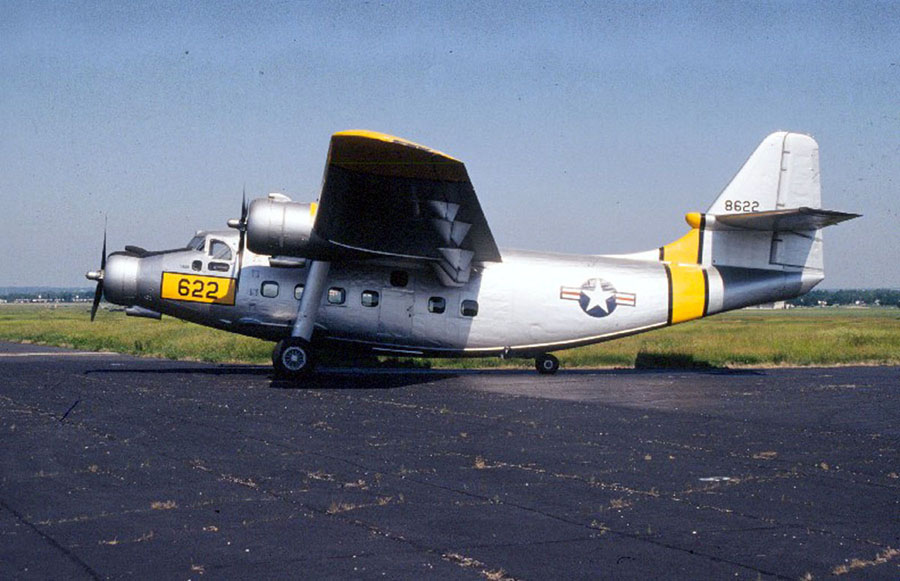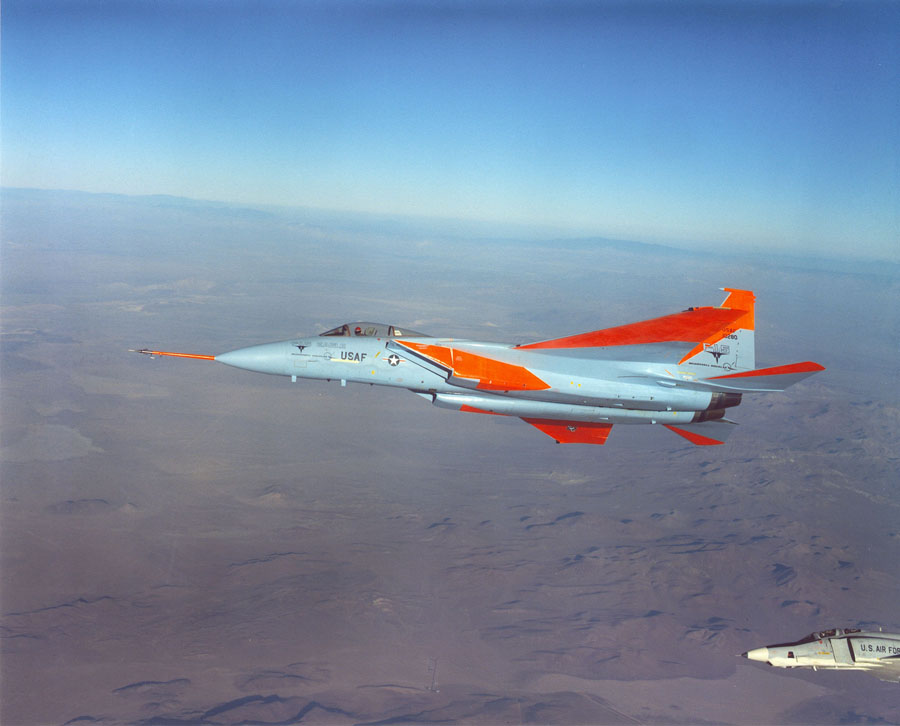
July 29, 1971: The Martin Marietta X-24A lifting body completed its flight test program. It was then converted to a different shape with the X-24B designation. The X-24 was one of a group of lifting bodies flown by the National Aeronautics Space Administration Flight Research Center, in a joint program with the U.S. Air Force at Edwards Air Force Base in California from 1963 to 1975.
The lifting bodies were used to demonstrate the ability of pilots to maneuver and safely land wingless vehicles, designed to fly back to Earth from space and be landed like an airplane at a predetermined site. Lifting bodies’ aerodynamic lift, essential to flight in the atmosphere, was obtained from their shape.
The addition of fins and control surfaces allowed the pilots to stabilize and control the vehicles and regulate their flight paths. The X-24 was built by Martin Marietta and flown from Edwards AFB, Calif. The X-24A was the fourth lifting body design to fly; it followed the NASA M2-F1 in 1964, the Northrop HL-10, the Northrop M2-F2 in 1966 and preceded the Northrop M2-F3.
The X-24A was a fat, short teardrop shape with vertical fins for control. It made its first, unpowered, glide flight on April 17, 1969. with Air Force Maj. Jerauld R. Gentry at the controls. Gentry also piloted its first powered flight on March 19, 1970. The craft was taken to around 45,000 feet (13.7 km) by a modified B-52 and then drop launched, then either glided down or used its rocket engine to ascend to higher altitudes before gliding down. The X-24A was flown 28 times at speeds up to 1,036 mph (1,667 km/h) and altitudes up to 71,400 feet (21.8 km). The X-24B’s design evolved from a family of potential reentry shapes, each with higher lift-to-drag ratios, proposed by the Air Force Flight Dynamics Laboratory. To reduce the costs of constructing a research vehicle, the Air Force returned the X-24A to the Martin Marietta Corporation (as Martin Aircraft Company became after a merger) for modifications that converted its bulbous shape into one resembling a “flying flatiron” — rounded top, flat bottom, and a double delta platform that ended in a pointed nose. First to fly the X-24B was John Manke, a glide flight on Aug. 1, 1973. He was also the pilot on the first powered mission Nov. 15, 1973.

July 29, 1983: The F-15 Combined Test Force at Edwards Air Force Base, Calif., passed 10,000 hours of accident-free flight time. This was the first time in the history of U.S. fighter development that such a milestone had been reached.

July 30, 1935: First Lt. Arthur H. Skaer Jr., a member of the Air Corps Reserve and a Northrop test pilot, took off from Mines Field, now Los Angeles International Airport, to conduct spin tests in the Northrop 3A. He never returned. An extensive search was conducted of the Palos Verdes Peninsula and the Southern California coast, and an Air Corps plane spotted what looked to be fresh oil on the surface of the water, but no sign of the Northrop 3A or Skaer was ever found.
The Northrop 3A was a prototype pursuit built to compete for the U.S. Army Air Corps’ fighter contract. It flew against the Curtiss-Wright Model 75 Hawk, NX17Y, and the Seversky SEV-1XP, NX18Y. During flight testing, the Northrop entry was found to have undesirable spin characteristics and was returned to the builder for further work.
The United Press reported: “Fears for the safety of Lieutenant Arthur Skaer, lost in a test flight in a new ‘mystery’ pursuit plane (reportedly the fastest army plane in the world) deepened tonight when planes searching the desolate Palos Verdes hills, where he was last seen.
“The plane, the latest weapon in army air warfare, reportedly was able to travel 300 miles an hour, and was a secret design, rigidly guarded by the U.S. Army and officials of the Northrop factory, where it was built.”

July 30, 1954: The Grumman F-11 Tiger made its first flight. The aircraft was a supersonic, single-seat carrier-based U.S. Navy fighter aircraft in operation during the 1950s and 1960s. Originally designated the F11F Tiger in April 1955 under the pre-1962 Navy designation system, it was redesignated as F-11 Tiger under the 1962 United States Tri-Service aircraft designation system. The F-11 was used by the Blue Angels flight team from 1957-1969. Grumman Aircraft Corporation made 200 Tigers, with the last aircraft being delivered to the U.S. Navy on Jan. 23, 1959.

July 30, 1959: The Northrop F-5A Freedom Fighter made its first flight. The Northrop F-5 is a family of supersonic light fighter aircraft initially designed as a privately funded project in the late 1950s by Northrop Corporation. There are two main models, the original F-5A and F-5B Freedom Fighter variants and the extensively updated F-5E and F-5F Tiger II variants. The design team wrapped a small, highly aerodynamic fighter around two compact and high-thrust General Electric J85 engines, focusing on performance and low cost of maintenance.
Smaller and simpler than contemporaries such as the McDonnell Douglas F-4 Phantom II, the F-5 cost less to procure and operate, making it a popular export aircraft. Though primarily designed for a day air-superiority role, the aircraft is also a capable ground-attack platform.
The F-5A entered service in the early 1960s. During the Cold War, over 800 were produced through 1972 for U.S. allies. Though at the time the U.S. Air Force did not have a need for a light fighter, it did procure approximately 1,200 Northrop T-38 Talon trainer aircraft, which was based on Northrop’s N-156 fighter design.
The first Air Force F-5A unit was the 4441st Combat Crew Training Squadron at the former Williams Air Force Base, near Phoenix, Ariz. The F-5 was also adopted as an opposing forces “aggressor” aircraft for dissimilar training role, because of its small size and performance similarities to the Soviet MiG-21. In this role, the aircraft saw service with the 64th Aggressor Squadron and the 65th Aggressor Squadron at Nellis Air Force Base, Nev.

July 30, 1959: Northrop’s N-156F, a fighter variation on its basic N-156T design, made its first flight, flown by Lewis “Lew” A. Nelson. With no market for a lightweight fighter then being apparent, the aircraft was soon mothballed by the company until it reappeared four years later as the F-5 Freedom Fighter.

July 30, 1959: The third and last X-15 rocket research plane (s/n 56-6672) arrived at Edwards Air Force Base, Calif.

July 30, 1971: The Apollo 15 command module, with astronauts David Scott and James Irwin, landed on the Moon. This was the ninth crewed mission of the Apollo program, with a longer stay on the Moon and a greater focus on science than earlier landings.
Apollo 15 saw the first use of the Lunar Roving Vehicle. The mission began on July 26 and ended on Aug. 7, with the lunar surface exploration taking place between July 30 and Aug. 2. Commander David Scott and Lunar Module Pilot James Irwin landed near Hadley Rille and explored the local area using the rover, allowing them to travel further from the lunar module than had been possible on previous missions. They spent 18 1/2 hours on the Moon’s surface on extravehicular activity and collected 170 pounds (77 kg) of surface material.
At the same time, Command Module Pilot Alfred Worden orbited the Moon, operating the sensors in the scientific instrument module bay of the service module. This suite of instruments collected data on the Moon and its environment using a panoramic camera, a gamma-ray spectrometer, a mapping camera, a laser altimeter, a mass spectrometer, and a lunar subsatellite deployed at the end of the moonwalks.
The lunar module returned safely to the command module and, at the end of Apollo 15’s 74th lunar orbit, the engine was fired for the journey home. During the return trip, Worden performed the first spacewalk in deep space. The Apollo 15 mission splashed down safely on Aug. 7 despite the loss of one of its three parachutes.
The mission accomplished its goals but was marred by negative publicity the following year when it emerged that the crew had carried unauthorized postal covers to the lunar surface, some of which were sold by a West German stamp dealer. The members of the crew were reprimanded for poor judgment and did not fly in space again. The mission also saw the collection of the Genesis Rock, thought to be part of the Moon’s early crust, and Scott’s use of a hammer and a feather to validate Galileo’s theory that when there is no air resistance, objects fall at the same rate due to gravity regardless of their mass.

July 30, 1997: The X-38 atmospheric test vehicle made its first captive-carry flight aboard a B-52. A joint project of NASA’s Dryden facility and the Johnson Space Center, the X-38 was a sub-scale, unmanned shape validation vehicle for a future International Space Station emergency Crew Return Vehicle. This Edwards History Office file photo features the first free flight of ship #2 taken on July 9, 1999.

July 31, 1941: The Lockheed Ventura made its first flight. The Ventura was a twin-engine medium bomber and patrol bomber of World War II. The Ventura first entered combat in Europe as a bomber with the Royal Air Force in late 1942. Designated PV-1 by the U.S. Navy, it entered combat in 1943 in the Pacific.
The bomber was also used by the U.S. Army Air Forces, which designated it the Lockheed B-34 (Lexington) and B-37 as a trainer. British Commonwealth forces also used it in several guises, including antishipping and antisubmarine search and attack.
The Ventura was developed from the Lockheed Model 18 Lodestar transport, as a replacement for the Lockheed Hudson bombers then in service with the Royal Air Force. Used in daylight attacks against occupied Europe, they proved to have weaknesses and were removed from bomber duty, and some used for patrols by Coastal Command. After USAAF monopolization of land-based bombers was removed, the U.S. Navy ordered a revised design which entered service as the PV-2 Harpoon for anti-submarine work.

July 31, 2015: The U.S. Marine Corps declared Initial Operational Capability with the F-35B. The largest procurement program in the Department of Defense the F-35 Lightning II is a strike fighter aircraft being procured in different versions for the United States Air Force, Marine Corps, and Navy. Current DOD plans call for acquiring a total of 2,456 F-35s. Allies are expected to purchase hundreds of additional F-35s, and eight nations are cost-sharing partners in the program with the United States.
The Navy Now joins the U.S. Marine Corps and U.S. Air Force as the third and final U.S. service to declare its F-35s mission ready and combat capable. Six F-35 operators are now IOC, to include the Marine Corps, U.S. Air Force, U.S. Navy, Israeli Air Force, Italian Air Force, and the United Kingdom.

Aug. 1, 1921: The Curtiss CR made its first flight. The Curtiss CR was a racing aircraft designed for the United States Navy in 1921 by Curtiss. It was a conventional single-seater biplane with a monocoque fuselage and staggered single-bay wings of equal span braced with N-struts. Two essentially similar landplane versions were built as the CR-1 and CR-2, which were both eventually converted to seaplanes as the CR-3 in 1923 and CR-4 in 1924.
A refined version was developed for the U.S. Army Air Service under the designation R-6. These latter two aircraft featured refined aerodynamics included surface-mounted radiators. The Curtiss CRs enjoyed successful racing careers. Their first major win was at the 1921 Pulitzer Trophy race, where piloted by Bert Acosta the CR-1 took first place with an average speed of 176.75 mph, nearly two minutes ahead of its closest rival.
The following year, this aircraft was modified and redesignated CR-2 and joined in the Pulitzer race by a second aircraft built to the same new standard, plus two R-6s flown by Army pilots.
These Curtiss aircraft took first through fourth place, the two R-6s followed by the two CR-2s. The race was won by Lt. Russell Maughan with an average speed of 205.856 mph with Lt. Lester Maitland in second place (198.850 mph).
Maughan’s effort broke every closed-circuit airspeed record up to 124 miles. The CR-2s took third and fourth places piloted by Lt Harold Brow (average speed 193.695 mph) and LTJG Al Williams (average speed 187.996 mph). The Army built upon this success with the R-6s by using the aircraft to break the world airspeed record before 1922 was over, Gen. Billy Mitchell flying one to 224.28 mph on Oct. 18.
In March the following year, an R-6 flown by Lt. Maughan lifted the record to 236.587 mph. The R-6 design was developed in 1923 into the longer-winged XPW-8, the prototype of the PW-8 fighter. In 1923, the CR-2s were fitted with floats for the Schneider Trophy race and redesignated CR-3.
The aircraft took first and second place, piloted by David Rittenhouse (average speed 177.977 mph and Rutledge Irvine 173.932 mph. After the 1924 Schneider Trophy race was cancelled, CR-3 A6081 was flown by Lt. G.T. Cuuddihy to set up new World’s closed-course seaplane record of 188.07 mph. A6081 was further modified as the CR-4 for use as a test bed and trainer for the 1926 Schneider Trophy racing team.

Aug. 1, 1929: Florence L. Barnes established herself in the aviation scene by setting a national speed record for women of 196.19 miles per hour in her Wright-powered Travel Air. In later years, known by her flamboyant nickname “Pancho,” she established herself as a hostess and friend of aviation at her ranch near Edwards AFB.
Having spent four months abroad in Mexico, getting caught up with revolutionaries and escaping the attention of authorities disguised as a man, she began to use the nickname : “Pancho” around this time. Barnes returned to San Marino, Calif., with an inheritance bequeathed to her on her parents’ death. In 1928, while driving her cousin Dean Banks to flying lessons, she decided to learn to fly, and convinced her cousin’s flight instructor, Ben Caitlin, a World War I veteran, of her desire that same day.
She soloed after six hours of formal instruction. Barnes ran an ad-hoc barnstorming show and competed in air races. Despite a crash in the 1929 Women’s Air Derby, she returned in 1930 under the sponsorship of the Union Oil Company to win the race and break Amelia Earhart’s world women’s speed record with a speed of 196.19 miles per hour. Barnes broke this record in a Travel Air Type R Mystery Ship.
After her contract with Union Oil expired, Barnes moved to Hollywood to work as a stunt pilot for movies. In 1931, she started the Associated Motion Picture Pilots, a union of film industry stunt fliers which promoted flying safety and standardized pay for aerial stunt work. She flew in several air-adventure movies of the 1930s, including Howard Hughes’ “Hell’s Angels.” Barnes had extensive connections in Hollywood.
Her early close friend George Hurrell — then eking out a living as a painter and photographer in Laguna Beach, California—would later become the legendary head of the portrait department of MGM Studios. Barnes is credited with helping Hurrell start his career in Hollywood after he took the photo she was to use on her pilot’s license, introducing him to her Hollywood friends. In a short period of time, Hurrell became the most in-demand photographer in Hollywood.
Barnes lost most of her money in the Great Depression. By 1935, she had only her apartment in Hollywood left. She sold it, and in March 1935 bought 180 acres of land in the Mojave Desert, near the Rogers dry lakebed and the nascent Muroc Field, then called March Field because it was an adjunct property of March Army Air Base at that time.

Aug. 1, 1949: The Northrop YC-125 Raider made its first flight. The Raider was a 1940s American three-engine STOL utility transport built by Northrop Corporation, Northrop’s first postwar civil design was a three-engine STOL passenger and cargo transport named the Northrop N-23 Pioneer. The Pioneer could carry 36 passengers or five tons of cargo and first flew on Dec. 21, 1946.
The aircraft had good performance, but there was little interest due to the availability of cheap war surplus aircraft. The Pioneer was lost in a fatal crash on Feb. 19, 1948, when it lost a new tailfin design in flight. In 1948, the U.S. Air Force expressed interest in an aircraft of the same configuration and placed an order with Northrop for 23 aircraft, 13 troop transports designated the C-125A Raider and 10 for Arctic rescue work designated the C-125B.

Aug. 1, 1955: With test pilot Anthony W. LeVier at the controls, the Lockheed U-2 high-altitude reconnaissance aircraft made its first flight Groom Lake, Nev. The planned first flight was several days away, but while LeVier was conducting taxi tests in preparation for that first flight, when at 70 knots the U-2 unexpectedly became airborne. LeVier later said, “I had no intentions whatsoever of flying. I immediately started back toward the ground but had difficulty determining my height because the lakebed had no markings to judge distance or height. I made contact with the ground in a left bank of approximately 10 degrees.”
Upon landing on the dry lake, the tires blew out and the brakes caught fire. Damage was minor and the aircraft was soon ready to fly again, which it did for the official first flight on Aug. 4, with LeVier at the controls.
The Lockheed U-2A is a single-place, single-engine aircraft powered by a turbojet engine, intended for very high-altitude photographic reconnaissance. Thirty U-2A aircraft were designed and built for the Central Intelligence Agency by Lockheed Aircraft Corporation’s secret “Skunk Works” under the supervision of Clarence L. “Kelly” Johnson.

Aug. 1, 1973: The Martin Marietta X-24B made its first glide flight, with John Manke at the controls. It made its first powered flight on Nov. 15, 1973. The X-24 was one of a group of lifting bodies flown by the NASA Flight Research Center in a joint program with the U.S. Air Force at Edwards Air Force Base from 1963 to 1975. The lifting bodies were used to demonstrate the ability of pilots to maneuver and safely land wingless vehicles designed to fly back to Earth from space and be landed like an airplane at a predetermined site. Lifting bodies’ aerodynamic lift, essential to flight in the atmosphere, was obtained from their shape. The addition of fins and control surfaces allowed the pilots to stabilize and control the vehicles and regulate their flight paths.
The X-24 was built by Martin Marietta and flown from Edwards AFB. The X-24A was the fourth lifting body design to fly; it followed the NASA M2-F1 in 1964, the Northrop HL-10 in (1966), the Northrop M2-F2 in 1966 and preceded the Northrop M2-F3 (1970).
The X-24B’s design evolved from a family of potential reentry shapes, each with higher lift-to-drag ratios, proposed by the Air Force Flight Dynamics Laboratory. To reduce the costs of constructing a research vehicle, the Air Force returned the X-24A to the Martin Marietta Corporation (as Martin Aircraft Company became after a merger) for modifications that converted its bulbous shape into one resembling a “flying flatiron” with a rounded top, flat bottom, and a double delta platform that ended in a pointed nose.

Aug. 1, 2002: Scaled Composites White Knight made its first flight from the Mojave Airport in California (now the Mojave Air and Space Port). The White Knight is a jet-powered carrier aircraft that was used to launch its companion SpaceShipOne, an experimental spaceplane. The White Knight and SpaceShipOne were designed by Burt Rutan and manufactured by Scaled Composites, a private company founded by Rutan in 1982.
On three separate flights in 2004, White Knight conducted SpaceShipOne into flight, and SpaceShipOne then performed a sub-orbital spaceflight, becoming the first private craft to reach space. The White Knight is notable as an example of a mother ship which carried a parasite aircraft into flight, releasing the latter which would then execute a high-altitude flight, or a sub-orbital spaceflight.
This flight profile is shared with The High and Mighty One and Balls 8, two modified B-52s which carried the North American X-15 into flight. It is also shared with White Knight Two, a descendant which carries SpaceShipTwo into flight as part of the Virgin Galactic fleet. Following the SpaceShipOne flights, the White Knight was contracted for drop tests of the Boeing X-37 spaceplane, from June 2005 until April 2006. The White Knight was retired from service in 2014.

Aug. 2, 1911: Harriet Quimby became the first woman in the United States to receive a pilot certificate, issued to her by the Aero Club of America. In 1912, she became the first woman to fly across the English Channel. Although Quimby lived only to the age of 37, she advanced the role of women in aviation.

Aug. 2, 1923: The Wright F2W made its first flight. The F2W was an American racing aircraft built by Wright Aeronautical Corporation for the U.S. Navy. The F2W was ordered by the Navy to enter in the 1923 Pulitzer Trophy. Wright built the aircraft primarily of wood, covered in fabric, and was powered by the Wright T-3 Tornado engine.
During the Pulitzer Race, the first F2W ran out of fuel and crashed. The second F2W, which carried twice as much fuel, finished third at 230.06 mph. It was later converted into a floatplane as the F2W-2 to take part in the 1924 Schneider Trophy race.
During testing it was very unstable, and on its only flight Oct. 11, 1924, the F2W-2 crashed into the Delaware River at Philadelphia, Penn., when the tremendous torque of the Tornado engine flipped it onto its back while attempting to land. The pilot, badly injured, extricated himself from the wreckage.

Aug. 2, 2006: A C-5 Galaxy taxied across a series of ramps laid out on Rogers Dry Lakebed as part of its Reliability Enhancement and Re-Engineering Program. The taxi runs tested the structural integrity and movement of the aircraft’s new engines and pylons under rough conditions.

Aug 3, 1972: The McDonnell Douglas YF-15A-1-MC Eagle prototype, 71-0280, went supersonic for the first time, reaching Mach 1.5 at Edwards Air Force Base, Calif. An air-superiority fighter, the F-15 entered service with the U.S. Air Force in 1975. More than 1,500 fighter, two-seat trainer, and two-seat F-15E Strike Eagle fighter-bombers have been built by McDonnell Douglas (now Boeing) and Mitsubishi. It is operated by allied air forces around the world and is expected to remain in front line service until 2025.

Aug. 3, 1973: The Air Force Flight Test Center at Edwards Air Force Base, Calif., accepted the first Northrop F-5E for formal Air Force developmental test and evaluation.

Aug. 3, 1982: The A-10 CTF conducted the first flight of the single-seat, night-attack program to determine if the cockpit of a single-seat aircraft could be optimized for the night mission. The two-seat YB-10B prototype trainer was used, with a safety observer in the rear cockpit.

Aug. 4, 1908: In demonstrate the capabilities of his airship, Ferdinand Adolf Heinrich August Graf von Zeppelin and LZ 4 departed from its floating hangar on Lake Constance on a planned 24-hour round trip down the Rhine to Basel, Strasbourg and Mainz, then back to Stuttgart, a distance of approximately 435 miles.
LZ 4 was 446 feet, 2 inches long and 42 feet, 6 inches in diameter. Buoyancy was provided by hydrogen contained in 17 rubberized cotton gas bags inside the dirigible’s rigid structure. The total volume of the airship was 530,003 cubic feet, and it was propelled by two Daimler engines, producing 105 horsepower each, and driving three-bladed propellers. Its maximum speed was 29.8 miles per hour.

Aug. 4, 1950: In the Korean War, during the Battle of the Pusan Perimeter, wounded soldiers were evacuated from the battlefield by helicopter for the first time. A Sikorsky H-5F of the U.S. Air Force’s Detachment F, 3rd Emergency Rescue Squadron, Air Rescue Service flew Army Private 1st Class Claude C. Crest, Jr. from the Sengdang-ni area to an Army hospital. By the end of combat in 1953, 21,212 soldiers had been medevaced by helicopters. Only the second military helicopter, the H-5 was frequently flown overloaded and outside of its center of gravity limits. The helicopter was not armed, though the pilot normally carried an M1911 .45-caliber semi-automatic pistol, and the crewman, a .30-caliber M1 Carbine.

Aug. 4, 1960: Joe Walker, NASA research pilot, set an unofficial world speed record in the number one North American X-15 when he flew the aircraft to 2,195 mph. This was the 18th flight of the X-15 program, this aircraft’s eighth flight, and Walker’s fourth. The X-15 was airdropped from the NB-52 mothership over Silver Lake, near the California-Nevada border. Walker fired the X-15ís two Reaction Motors engines for 264.2 seconds. The X-15 accelerated to Mach 3.31 and climbed to a peak altitude of 78,112 feet. Walker touched down on Rogers Dry Lake at Edwards Air Force Base, Calif., after a flight of 10 minutes, 22.6 seconds.





